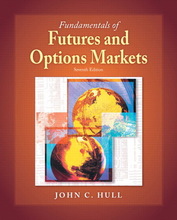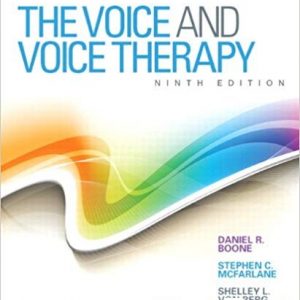This is completed downloadable of Fundamentals of Futures and Options Markets Hull 7th Edition Test Bank

Product Details:
- ISBN-10 : 0136103227
- ISBN-13 : 978-0136103226
- Author: John C. Hull
Based on Hull’s Options, Futures and Other Derivativesthe seventh edition of Fundamentals of Futures and Options Markets presents an accessible and reader-friendly overview of the topic without the use of calculus. Packed with numerical examples and accounts of real-life situations, this text effectively guides readers through the material while helping them prepare their skills and knowledge for the workplace.
The seventh edition addresses and analyzes the impact of the current financial crisis.
Table of Content:
Chapter 1 Introduction
1) A one-year forward contract is an agreement where
A) One side has the right to buy an asset for a certain price in one year’s time
B) One side has the obligation to buy an asset for a certain price in one year’s time
C) One side has the obligation to buy an asset for a certain price at some time during the next year
D) One side has the obligation to buy an asset for the market price in one year’s time
Answer: B
2) Which of the following is NOT true?
A) When a CBOE call option on IBM is exercised, IBM issues more stock
B) An American option can be exercised at any time during its life
C) An call option will always be exercised at maturity if the underlying asset price is greater than the strike price
D) A put option will always be exercised at maturity if the strike price is greater than the underlying asset price
Answer: A
3) A one-year call option on a stock with a strike price of $30 costs $3; a one-year put option on the stock with a strike price of $30 costs $4. Suppose that a trader buys two call options and one put option. The breakeven stock price above which the trader makes a profit is
A) $35
B) $40
C) $30
D) $36
Answer: A
4) A one-year call option on a stock with a strike price of $30 costs $3; a one-year put option on the stock with a strike price of $30 costs $4. Suppose that a trader buys two call options and one put option. The breakeven stock price below which the trader makes a profit is
A) $25
B) $28
C) $26
D) $20
Answer: D
5) Which of the following is approximately true when size is measured in terms of the underlying principal amounts or value of the underlying assets?
A) The exchange-traded market is twice as big as the over-the-counter market
B) The over-the-counter market is twice as big as the exchange-traded market
C) The exchange-traded market is ten times as big as the over-the-counter market
D) The over-the-counter market is ten times as big as the exchange-traded market
Answer: D
6) Which of the following best describes the term “spot price”?
A) The price for immediate delivery
B) The price for delivery at a future time
C) The price of an asset that has been damaged
D) The price of renting an asset
Answer: A
7) Which of the following is true about a long forward contract?
A) The contract becomes more valuable as the price of the asset declines
B) The contract becomes more valuable as the price of the asset rises
C) The contract is worth zero if the price of the asset declines after the contract has been entered into
D) The contract is worth zero if the price of the asset rises after the contract has been entered into
Answer: B
8) An investor sells a futures contract an asset when the futures price is $1,500. Each contract is on 100 units of the asset. The contract is closed out when the futures price is $1,540. Which of the following is true?
A) The investor has made a gain of $4,000
B) The investor has made a loss of $4,000
C) The investor has made a gain of $2,000
D) The investor has made a loss of $2,000
Answer: B
9) Which of the following describes European options?
A) Sold in Europe
B) Priced in Euros
C) Exercisable only at maturity
D) Calls (there are no puts)
Answer: C
10) Which of the following is NOT true?
A) A call option gives the holder the right to buy an asset by a certain date for a certain price
B) A put option gives the holder the right to sell an asset by a certain date for a certain price
C) The holder of a call or put option must exercise the right to sell or buy an asset
D) The holder of a forward contract is obligated to buy or sell an asset
Answer: C
11) Which of the following is NOT true about call and put options?
A) An American option can be exercised at any time during its life
B) A European option can only be exercised only on the maturity date
C) Investors must pay an upfront price (the option premium) for an option contract
D) The price of a call option increases as the strike price increases
Answer: D
12) The price of a stock on July 1 is $57. A trader buys 100 call options on the stock with a strike price of $60 when the option price is $2. The options are exercised when the stock price is $65. The trader’s net profit is
A) $700
B) $500
C) $300
D) $600
Answer: C
13) The price of a stock on February 1 is $124. A trader sells 200 put options on the stock with a strike price of $120 when the option price is $5. The options are exercised when the stock price is $110. The trader’s net profit or loss is
A) Gain of $1,000
B) Loss of $2,000
C) Loss of $2,800
D) Loss of $1,000
Answer: D
14) The price of a stock on February 1 is $84. A trader buys 200 put options on the stock with a strike price of $90 when the option price is $10. The options are exercised when the stock price is $85. The trader’s net profit or loss is
A) Loss of $1,000
B) Loss of $2,000
C) Gain of $200
D) Gain of $1000
Answer: A
15) The price of a stock on February 1 is $48. A trader sells 200 put options on the stock with a strike price of $40 when the option price is $2. The options are exercised when the stock price is $39. The trader’s net profit or loss is
A) Loss of $800
B) Loss of $200
C) Gain of $200
D) Loss of $900
Answer: C
16) A speculator can choose between buying 100 shares of a stock for $40 per share and buying 1000 European call options on the stock with a strike price of $45 for $4 per option. For second alternative to give a better outcome at the option maturity, the stock price must be above
A) $45
B) $46
C) $55
D) $50
Answer: D
17) A company knows it will have to pay a certain amount of a foreign currency to one of its suppliers in the future. Which of the following is true?
A) A forward contract can be used to lock in the exchange rate
B) A forward contract will always give a better outcome than an option
C) An option will always give a better outcome than a forward contract
D) An option can be used to lock in the exchange rate
Answer: A
18) A short forward contract on an asset plus a long position in a European call option on the asset with a strike price equal to the forward price is equivalent to
A) A short position in a call option
B) A short position in a put option
C) A long position in a put option
D) None of the above
Answer: C
19) A trader has a portfolio worth $5 million that mirrors the performance of a stock index. The stock index is currently 1,250. Futures contract trade on the index with one contract being on 250 times the index. To remove market risk from the portfolio the trader should
A) Buy 16 contracts
B) Sell 16 contracts
C) Buy 20 contracts
D) Sell 20 contracts
Answer: B
20) Which of the following best describes a central clearing party?
A) It is a trader that works for an exchange
B) It stands between two parties in the over-the-counter market
C) It is a trader that works for a bank
D) It helps facilitate futures trades
Answer: B
People Also Search:
fundamentals of futures and options markets hull 7th edition
fundamentals of futures and options markets hull 7th edition download scribd
fundamentals of futures and options markets hull 7th edition test bank download pdf





